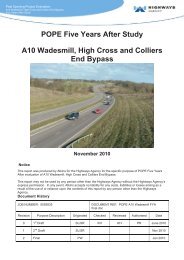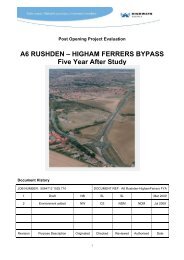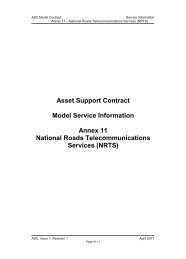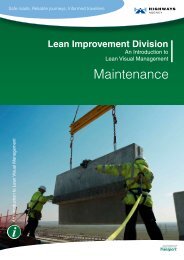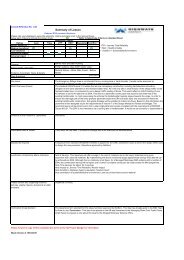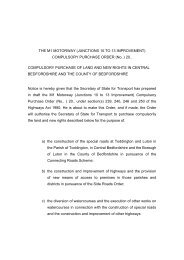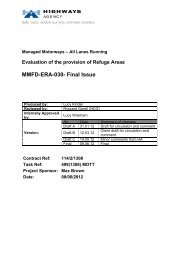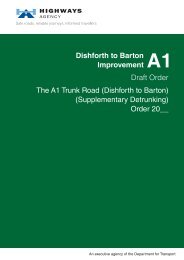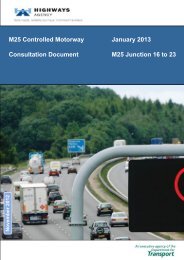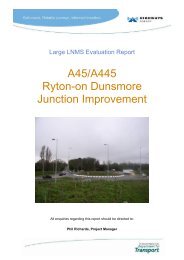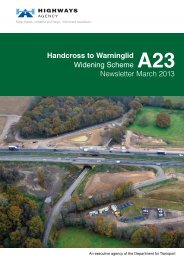Highways Agency Annual Report and Accounts 2011-2012
Highways Agency Annual Report and Accounts 2011-2012
Highways Agency Annual Report and Accounts 2011-2012
Create successful ePaper yourself
Turn your PDF publications into a flip-book with our unique Google optimized e-Paper software.
SECTION 10: Financial Statements<br />
1.8 Research <strong>and</strong> Development<br />
Expenditure on research is not capitalised. Expenditure on development is capitalised <strong>and</strong> written off over<br />
the useful life of the asset if it meets the criteria specified in the FReM. Expenditure that does not meet<br />
the criteria for capitalisation is treated as an expense <strong>and</strong> shown in the Statement of Comprehensive Net<br />
Expenditure in the year in which it is incurred.<br />
Non-current assets acquired for use in research <strong>and</strong> development are depreciated over the life of the<br />
associated project.<br />
1.9 Operating Income<br />
Operating income is income that relates directly to the operating activities of the <strong>Agency</strong>.<br />
It principally comprises fees <strong>and</strong> charges for services provided on a full-cost basis to external customers<br />
in both the public <strong>and</strong> private sectors. It includes not only income appropriated in aid of the Estimate but<br />
also income due to the Consolidated Fund, which in accordance with the FReM is treated as operating<br />
income. Operating income is stated net of VAT, <strong>and</strong> is measured at the fair value of the consideration<br />
received or receivable.<br />
1.10 Administration <strong>and</strong> Programme Expenditure<br />
The Statement of Comprehensive Net Expenditure is analysed between administration <strong>and</strong> programme<br />
income <strong>and</strong> expenditure. The classification of expenditure <strong>and</strong> income as administration or as programme<br />
follows the definition of administration costs set by HM Treasury. In line with other Arms Length Bodies,<br />
the classification applied by the <strong>Agency</strong> was reviewed <strong>and</strong> clarified as part of the SR10 exercise. This<br />
resulted in some expenditure being reclassified between the two categories to ensure the <strong>Agency</strong>’s<br />
approach was consistent with that now being applied across central government.<br />
Administration costs reflect the costs of running the <strong>Agency</strong> <strong>and</strong> include expenditure on administrative<br />
staff (such as wages <strong>and</strong> salaries, training <strong>and</strong> development <strong>and</strong> travel expenditure) <strong>and</strong> associated costs<br />
including accommodation, IT <strong>and</strong> office supplies.<br />
Programme costs reflect the costs of operating, managing, maintaining <strong>and</strong> improving the motorway <strong>and</strong><br />
trunk road network. They include staff costs where they directly relate to service delivery.<br />
1.11 Pensions <strong>and</strong> other employee benefits<br />
Past <strong>and</strong> present employees are covered by the provisions of the Principal Civil Service Pension<br />
Scheme (PCSPS), which are described in Note 3. The defined schemes are unfunded <strong>and</strong> are mostly<br />
non-contributory except in respect of dependants’ benefits. The <strong>Agency</strong> recognises the expected<br />
cost of these elements on a systematic <strong>and</strong> rational basis over the period during which it benefits from<br />
employees’ services by payment to the PCSPS of amounts calculated on an accruing basis. Liability for<br />
payment of future benefits is a charge on the PCSPS. In respect of the defined contribution schemes, the<br />
<strong>Agency</strong> recognises the contributions payable for the year.<br />
The <strong>Agency</strong> recognises liabilities for short-term employee benefits (which fall due within twelve months<br />
of the period in which they are earned). In practice, all material short-term employee benefits are settled<br />
during the period in which they are earned.<br />
The <strong>Agency</strong> is required to pay, as termination benefits, the additional cost of benefits, beyond the normal<br />
PCSPS benefits, in respect of employees who retire early, unless the retirements are on approved medical<br />
grounds. The <strong>Agency</strong> recognises the full cost of benefits (including pensions payable up to the normal<br />
retirement age <strong>and</strong> lump sums) as an expense <strong>and</strong> liability when it becomes demonstrably committed to<br />
providing those benefits.<br />
1.12 Leases<br />
At their inception, leases are classified as operating or finance leases, based on the extent to which the<br />
risks <strong>and</strong> rewards of ownership lie with the <strong>Agency</strong>. In making the classification, the <strong>Agency</strong> does not<br />
separate the l<strong>and</strong> <strong>and</strong> buildings elements of arrangements which cover both elements.<br />
Arrangements, including some PFI contracts that are not service concessions, whose fulfilment is<br />
<strong>Highways</strong> <strong>Agency</strong> <strong>Annual</strong> <strong>Report</strong> <strong>and</strong> <strong>Accounts</strong> <strong>2011</strong>-12



